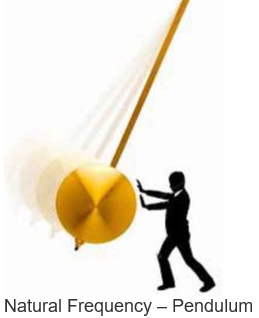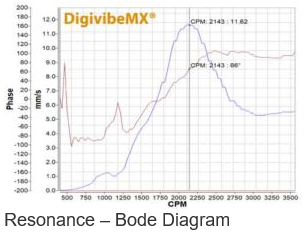Five Minute Facts
Resonance & Natural Frequency
3 tips for diagnosing resonance and 6 ways to correct it coming next.
Facts
Resonance represents 40% of cases of recurrent imbalance and it is also, despite being so easy to diagnose, one of the most frequently overlooked faults.
Among the most common faults, resonance is the one with the greatest destructive forces. It is also the protagonist of 90% of structural fractures due to material and welding fatigue as well as the reduction in the service life of the bearings due to overload.
Definition of Natural Frequency
To understand resonance, we first have to understand natural frequency. Definition says something like this:
The natural frequency is the frequency at which an object will remain vibrating after hitting it. This cannot be clearer (hitting the bell, pushing my daughter on the swing).
All objects and mechanical systems have a natural frequency. They may even have many natural frequencies depending on their geometry.
NOW! What happens when you excite that object at the same frequency as its natural frequency? Well, that is resonance.
Definition of Resonance
Resonance is a phenomenon that amplifies a vibration. It occurs when a vibration is transmitted to another object whose natural frequency is equal or very close to that of the source.
Check also Wikipedia’s Definition.
Examples
Look at the example of a pendulum.

When I push the pendulum, the energy that I apply is not immediately lost. Instead, it remains in the form of a pendulum movement that will slowly get lost. If I push it once every cycle, that new energy is accumulated to the energy that was already in the pendulum in the form of movement, just like when you push your child on the swing.

Observe the opposite case. When I stimulate the pendulum to a different frequency, I will be fighting against the energy that was already accumulated; thus, no energy will be added to the existing one.
Something very similar happens in rotating machinery. When the speed of a motor is close to its natural frequency it will resonate. Thus, any vibration due to imbalance, as small it might be, will be amplified. In this way, small weights will cause surprisingly large changes in vibration.
Finally, and as if all of this were not enough, the vibration of a machine does not behave linearly. The amount of vibration produces small structural changes that momentarily change the natural frequency as well as the damping, causing it to behave slightly different at different levels of vibration. All of this turns balancing complicated.
Learn How to Diagnose Resonance
Resonance is easy to diagnose; however, it is important to be able to suspect it. A machine, during run-up, will gradually increase its vibration; resonance will make vibration increase suddenly as the machine reaches its final speed. The same happens in coast down, when the RPM gets a small distance from the natural frequency, the vibration decreases immediately.
There are 3 tests that you can do in order to diagnose resonance.
Run-Up or Coast Down Test | Resonance
This test is performed by recording the vibration during the stoppage. Confirm that effectively the vibration dramatically decreases within the first few seconds.
Bump Test | Natural Frequency
In the “bump test” the recording of the vibration is made after hitting the machine. In the spectrum you will then observe the resonant frequencies of the structure. You can confirm the diagnosis with 95% certainty, in case any of those frequencies is close to the rotation speed (be sure you know with certainty the speed of rotation). Usually this study is enough to diagnose the resonance; however, there is another test in case of needing a confirmatory test.


Bode Plot in Resonance Analysis
Bode diagram is a coast down or run-up test that integrates vibration and RPM measured by a tachometer or RPM sensor. This test calculates the FFT and the phase related to the RPM signal at each time interval. This test confirms the resonance by observing a change in the 180º phase between the moments before and after crossing the suspected frequency.

Correct Resonance
The good news is that the resonance phenomenon is easy to correct. Simply move the natural frequency away from the excitation frequency.
Correction actions are divided in 2:
Modify the Natural Frequency
You can increase the natural frequency by increasing the rigidity of the structure. Make sure to reinforce the structure the same direction of the natural frequency. This is the most common solution to avoid changing the performance of the machine.
You can also decrease the natural frequency by removing rigidity to the structure. It is not as common, but it is equally possible and effective, provided that the performance of the machine is not compromised.
You can decrease the natural frequency by adding mass. Changing the mass of a structure will change its natural frequency and therefore also move it away from its rotation speed.
You can also increase the natural frequency by removing mass. This is the least frequent action, but it is equally effective.
Modify the RPM to Move It Away from the Natural Frequency
If a drive controls the motor speed, then change the RPM. It is the simple thing to do. In case having a belt/pulleys transmission, changing the diameter of the pulley could be the solution. In any case, it is important to verify that the performance of the machine remains enough for its functions, and of course that the current consumption does not exceed manufacturer´s recommendation.






